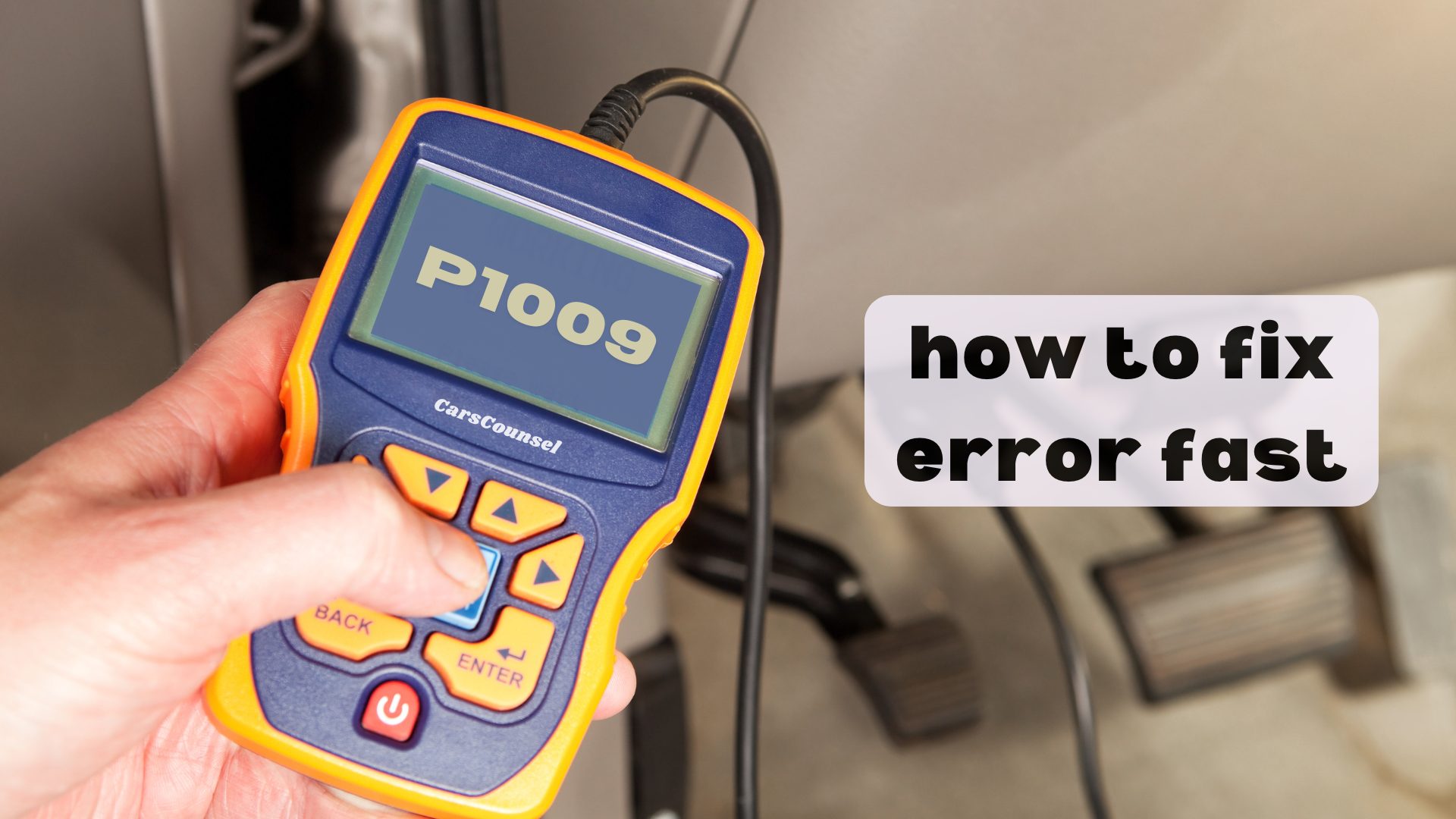Did you know that over 60% of drivers get the P1009 code because of problems with their car’s variable valve timing system? If you’re one of them, you’ll want to fix this quickly to avoid expensive repairs.
Start by using an OBD2 scanner to confirm the OBD2 code error and check for any other codes. Then, look at the VVT solenoid and make sure all electrical connections are tight.
But that’s just the start—there are several more steps you need to take to fix this problem quickly and prevent it from coming back.
Let’s go through these steps in detail.

Quick Navigation
Key Takeaways
- Look over the VVT solenoid for any damage, and clean or replace it if needed.
- Check oil passages for blockages and clear them to make sure oil flows properly.
- Use an OBD2 scanner to confirm the P1009 code and reset it after making repairs.
- Check for and fix any damaged or worn-out wiring in the VVT system.
What Is the P1009 Code?
The P1009 code signals a problem with your car’s variable valve timing (VVT) control system, often tied to issues with the camshaft or crankshaft position sensors.
VVT helps your engine run better by adjusting the timing of the camshafts. When this system has a problem, it can cause poor combustion, less power, and bad fuel efficiency.
To figure out what’s wrong, use an OBD2 scanner to confirm the P1009 code. Look at the VVT parts for any visible damage or loose connections.
Check the oil pressure sensor with a gauge to make sure it’s working right. Use a multimeter to test the electrical system for proper continuity and voltage.
Correct diagnosis ensures you fix the P1009 code properly, helping your engine run smoothly and efficiently again.
Causes of P1009 Code
If your car has a P1009 code, it usually means there’s a problem with the valve timing control system.
Start by checking the valve timing control solenoid, since it’s often the main issue. Look for any signs of damage or wear on the solenoid.
Another possible cause could be blocked oil passages, which can mess with the oil flow and pressure needed for the system to work right. Make sure the oil in your car is clean and the right type; bad or wrong oil can seriously mess up the system.
Also, don’t forget to check the wiring—damaged or frayed wires can cause problems.
Lastly, make sure the oil pressure sensor is working correctly, as a bad sensor can give false readings.
Following these steps should help you find out what’s causing the P1009 code.
Symptoms of P1009 Code
If you see a P1009 code, your engine might misfire or run rough when idling.
You’ll probably notice the car doesn’t accelerate well and feels less powerful. The Check Engine Light will come on, telling you something needs fixing right away.
Listen for strange noises from the engine, especially when starting the car, which could mean there’s a problem with the VVT system. Also, you might find your car uses more fuel than usual.
To fix a P1009 code, first check the VVT parts for any damage or loose connections.
Make sure your oil is clean and of good quality, as dirty oil can mess up the VVT system.
Regular maintenance of the VVT system is crucial—keep the oil passages clean and replace any bad sensors quickly.
Doing these things can help solve the problem and get your car running smoothly again.
Affected Car Models
Affected Car Models
Several car models often run into the P1009 code because of issues with their variable valve timing systems. Problems with Acura, Honda, Nissan, and Toyota vehicles are common and usually need repairs to fix this error. Here’s a quick list of the affected models:
| Car Model | Years | Engine |
|---|---|---|
| Acura TSX | 2004-2008 | 2.4-liter |
| Honda Civic | 2006-2011 | 1.8-liter |
| Honda CR-V | Various | Varies |
| Toyota Camry | Various | Varies |
To diagnose these models, you need to check the VVT components, use an OBD2 scanner, and look at the oil pressure sensors. Taking quick action ensures the car runs well and prevents more problems. Always follow the manufacturer’s guidelines for the right steps and repairs.
Diagnostic Tools Needed
To diagnose the P1009 code, you’ll need an OBD2 scanner, a multimeter, and an oil pressure gauge.
Start by connecting the OBD2 scanner to your vehicle’s diagnostic port to read and clear any trouble codes. This will help you see if P1009 is the main problem.
Next, use the multimeter to check the electrical connections and voltage of the VVT solenoid and its wiring. Make sure there are no breaks or shorts.
Finally, use the oil pressure gauge to check the engine’s oil pressure. Low pressure can mean there are blockages in the oil passages or a faulty oil pressure sensor.
These tools and steps will help you find the exact cause of the P1009 code quickly and easily.
Inspecting VVT Components
Start by looking at the VVT solenoid for any signs of wear, damage, or oil buildup. If you see any problems, replace the solenoid using a guide.
Next, make sure the electrical connections are tight and not corroded. To be thorough, disconnect the solenoid and use a multimeter to check the resistance.
Clean any oil passages that seem blocked to keep the oil flowing well, which is important for VVT maintenance. Check the wiring harness for any frays or breaks and fix them if needed.
Ensure all parts are put back together correctly and securely.
Following these steps will help you find and fix VVT issues efficiently, reducing the chance of getting P1009 errors again.
Checking Oil Pressure
Start by attaching an oil pressure gauge to the engine to get an accurate reading of the oil pressure. Make sure the engine is at its normal operating temperature. Turn on the engine and note the pressure readings at both idle and higher speeds. Compare these readings to what the manufacturer recommends.
If the oil pressure is too low, it can mess with the VVT (Variable Valve Timing) system. Check the oil quality; if the oil is dirty or the wrong type, it can give you false readings and cause VVT problems.
Change the oil and filter if needed. Also, check for any blockages in the oil passages that might be stopping the flow. Fixing these oil pressure issues is important before you move on to more complicated diagnostics.
This step ensures the VVT system gets the right lubrication and works properly.
Testing Electrical System
Testing the electrical system means using a multimeter to check if the circuits for the VVT (Variable Valve Timing) are working right.
First, disconnect the battery to stay safe.
Find the VVT solenoid and its wiring.
Set your multimeter to continuity mode and check for any breaks in the connections.
Then, switch to voltage mode to see if the solenoid is getting the right amount of power, according to your vehicle’s manual.
Look closely at the wires for any damage like fraying.
Make sure all connections are tight and not corroded.
If you find any issues, fix them before moving on to other tests.
Fixing P1009 Code
To fix the P1009 code, you’ll need to replace the faulty VVT solenoid, clean any blocked oil passages, and repair any damaged wiring. Make sure your engine oil is clean and at the right level, as dirty oil can affect VVT performance. Follow the steps below:
| Step | Action |
|---|---|
| Replace VVT Solenoid | Remove the old solenoid and install a new one |
| Clean Oil Passages | Use an engine flush or take apart the parts to clear blockages |
| Repair Wiring | Check and fix any damaged or frayed wires |
Repair Costs
Fixing the P1009 code can cost a lot or a little, depending on what’s wrong and what parts need to be replaced. On the low end, it could be about $100, but on the high end, it might go up to $2,000.
The cost of labor usually falls between $75 and $150 an hour, and parts like sensors or solenoids can range from $50 to $500. You might also have to pay for a diagnostic check, which is generally between $100 and $200.
To get a clear idea of the costs, talk to a good mechanic who can check out the specific problems. They can tell you if you just need a new solenoid or if the issue is bigger, like cleaning blocked oil passages or fixing damaged wiring.
It’s a good idea to get quotes from a few places to make sure you get the best deal.
More OBD-II Codes
Frequently Asked Questions
Can Driving With a P1009 Code Damage My Engine?
Driving with a P1009 code can harm your engine. Bad oil and reduced engine performance can cause more problems. Check the VVT system and oil quality right away to avoid expensive damage and keep your engine running well.
How Often Should the VVT System Be Serviced to Prevent P1009?
You should service the VVT system every 30,000 to 50,000 miles. Regular maintenance ensures the VVT system works well and helps prevent problems like the P1009 code. During maintenance, check the oil quality, VVT solenoid, and wiring.
Are There Any DIY Methods to Temporarily Fix the P1009 Code?
Imagine your car’s VVT system like a steam engine. You can try temporary fixes like cleaning the solenoid or checking the oil levels. You can also use diagnostic tools to clear the codes. However, it’s best to get professional help.
What Are the Long-Term Effects of Ignoring the P1009 Code?
Ignoring the P1009 code can lead to serious problems over time. Your engine might not run well, you’ll use more fuel, and you could end up with engine damage. Fixing the issue right away can save you money on repairs and keep your car running smoothly.
Are There Any Specific Driving Conditions That Worsen P1009 Symptoms?
Have you ever thought about whether the way you drive or the weather could make P1009 symptoms worse? They can. Driving aggressively and very hot or cold temperatures can put extra strain on the VVT system, making problems like engine misfires, rough idling, and losing power even worse.
Conclusion
To fix the P1009 code quickly, follow these simple steps:
Use an OBD2 scanner to confirm the error.
Check the VVT solenoid and its electrical connections.
Clean any blocked oil passages.
Check the oil pressure.
If necessary, replace the faulty solenoid and use the correct engine oil.
Remember, regular maintenance can prevent many issues and keep your engine running smoothly.

